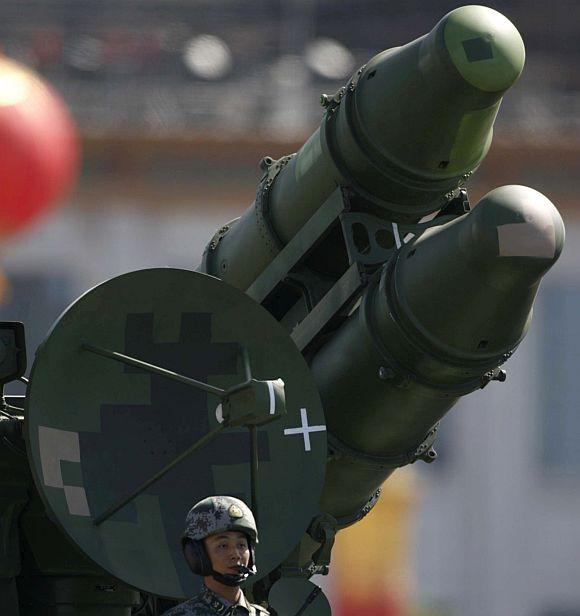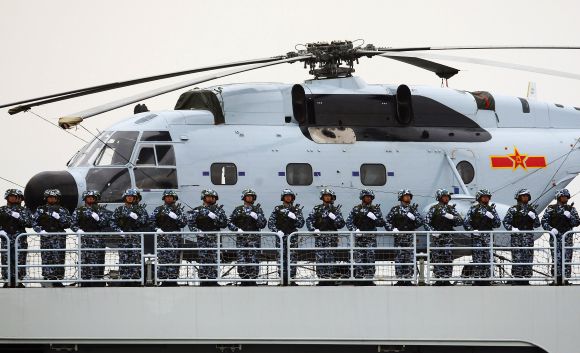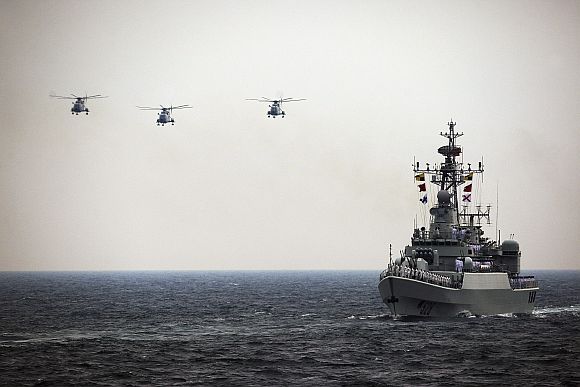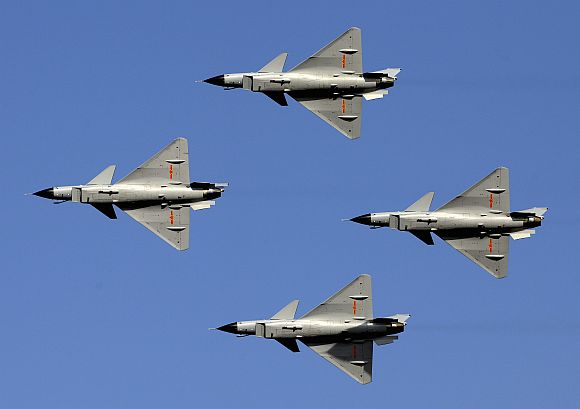 | « Back to article | Print this article |
Why escalating Chinese defence budget is ALARMING!
What has been causing concern in Asia and beyond is the opacity that seems to surround China's military build-up, with an emerging consensus that Beijing's real military spending is at least double the announced figure, says Harsh V Pant.
Another year and another big increase in defence spending! Once again this year China has announced a double-digit increase in its military spending as concerns continue to rise in the region and beyond about China's true intentions behind its building of capabilities.
Last week Beijing announced that the total defence budget for 2012 would be increased to $106 billion from $95.6 billion last year, an increase of 11.2 percent.
And this is when vital elements of the Chinese military build-up, including cyberwarfare and space capabilities, as well as foreign procurements, were not included in the announced budget.
The bulk of the increased defence spending will go to the Chinese navy and air force, and to the second artillery corps which runs the strategic nuclear forces.
Click here for more Realtime News on China!
Please click NEXT to read further...
Real figures are much higher than those revealed
The spokesman of the National People's Congress which announced the military budget, suggested that the military spending increase was in line with Chinese economic development, and as a percentage of gross domestic product compared with other countries, specifically the United States and Britain, the increase was relatively low.
Without any sense of irony, he went on to argue that that "China is committed to the path of peaceful development" and "follows a defence policy that is peaceful in nature".
A growing economic power, China has been concentrating over the last decade on the accretion of military might so as to secure and enhance its own strategic interests. China, which has the largest standing army in the world with more than 2.3 million members, continues to make the most dramatic improvements in its nuclear force among the five nuclear powers and improvements in its conventional military capabilities are even more impressive.
What has been causing concern in Asia and beyond is the opacity that seems to surround China's military build-up, with an emerging consensus that Beijing's real military spending is at least double the announced figure.
The official figures of the Chinese government do not include the cost of new weapon purchases, research or other big-ticket items for China's highly secretive military and as a result, the real figures are much higher than the revealed amount.
Just last year, it has been estimated that China ended up spending $160 billion instead of the announced $95.6 billion.
Clearly, China's sights are focused on the US
China continues to defend its military upgradation by claiming that it needs offensive capability for Taiwan-related emergencies. But clearly, its sights are now focused on the US.
China wants to limit American ability to project power into the Western Pacific. It wants to prevent a repeat of its humiliation in 1996, when the US aircraft carriers could move around unmolested in the Taiwan Strait and deter Chinese provocations.
Not surprisingly, the steady build-up of a force with offensive capabilities well beyond Chinese territory is causing consternation in Washington and among China's neighbours.
This comes at a time of Chinese assertiveness on territorial disputes with Japan, India and Southeast Asian countries.
The Obama administration has been asking Beijing for greater transparency in the Chinese military budget and for deeper communication between the two militaries; and this call was revived during the recent visit to Washington by Vice President Xi Jinping, who is likely to be the next leader of China.
Since last year, in order to gain a greater understanding of Chinese defence policy, the US has initiated formal talks known as a strategic security dialogue which are attended by senior civilian and military officials from Beijing and Washington. But the results so far have not been very encouraging.
China's modernisation programme producing results faster than expected
China's largely secretive military modernisation programme is producing results faster than expected. Beijing is gearing up to challenge the US military prowess in the Pacific.
It is refitting a Soviet-era Ukrainian aircraft carrier for deployment next year and more carriers are under construction in Shanghai.
China's submarine fleet is the largest in Asia and is undergoing refurbishments involving nuclear-powered vessels and ballistic missile equipped subs. Its anti-ship ballistic missile system, developed specifically to target US carrier strike groups, has reached initial operational capability much earlier than expected.
China's programme to build and acquire more sophisticated, modern weaponry has resulted in a new indigenous J-20 stealth fighter jet, which made a test flight last year.
China has already shown its prowess in anti-satellite warfare and has redeployed its nuclear warheads onto mobile launchers and advanced submarines. In a marked shift in China's no-first-use policy, Chinese leaders have indicated that they would consider launching pre-emptive strikes if they found the country in a 'critical situation', thereby lowering the threshold of nuclear threats.
There is a growing debate in the Peoples Liberation Army about whether to discard conditionalities on China's commitments to no-first use.
China is a rising power with the world's second largest economy and a growing global footprint. It would like to have a military ready and willing to defend these interests.
But it is the opaqueness surrounding China's military upgradation that is the real sources of concern. China does not believe in transparency. In fact, the PLA follows Sun Tzu who argues that 'the essence of warfare is creating ambiguity in the perceptions of the enemy'.
Capability differential between India and China rising alarmingly
This year's dramatic rise in Chinese defence spending comes at a time when the US has initiated its foreign policy pivot towards Asia. As US Secretary of State Hillary Clinton has already underlined, 'The future of politics will be decided in Asia, not Afghanistan or Iraq, and the United States will be right at the centre of the action.'
At a time when talk of American decline and retrenchment from global commitments has become de riguer, the signals coming from Washington are that it has no intention of leaving the Asian strategic landscape. Nor will regional states allow America to lower its profile.
After all, the elephant in the room (region) is China's faster than expected ascent in global inter-state hierarchy. The new defence strategy outlined by Washington recently is explicitly geared towards tackling the emerging threat from China's massive and rapid military build-up.
It takes forward the already underway process of reorienting the American military might from the Atlantic to the Pacific.
With his visit to Asia last November and with a new military strategy that focuses on the region, the Obama administration is underscoring America's commitment to regional stability at a time when the US is wrapping up two wars in Iraq and Afghanistan.
This new strategy is unambiguous in underlining the challenge in the Asia-Pacific and turning America's gaze to this geo-strategically pivotal region and to China's growing prowess. 'As I made clear in Australia, we'll be strengthening our presence in the Asia-Pacific, and budget reductions will not come at the expense of this critical region,' Obama remarked at the Pentagon while releasing the new strategy.
It remains to be seen how successful this strategy will be in meeting the challenges of the future but it should give some respite to regional states, including India, who are confronted with a rapidly rising China and all its attendant consequences.
At a time when tensions between China and India are rising by the day, the Indian government is yet to demonstrate the political will to tackle the defence policy paralysis that seems to be rendering all the claims of India's rise as a military power increasingly hollow.
The capability differential between China and India is rising at an alarming rate. Unless something dramatic is done to redress this growing imbalance, this will continue to constrain India's rise as a major regional and global player of any significance.





